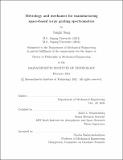Metrology and mechanics for manufacturing space-based x-ray grating spectrometers
Author(s)
Song, Jungki.
Download1252628750-MIT.pdf (46.02Mb)
Other Contributors
Massachusetts Institute of Technology. Department of Mechanical Engineering.
Advisor
Mark L. Schattenburg.
Terms of use
Metadata
Show full item recordAbstract
Small errors in critical dimensions (CDs) or deformation of optical components can lead to severe performance degradation in high-resolution imaging and spectroscopy tools. Consistent innovations towards more precise optical elements and assembly procedures have led to high-resolution optical systems in many fields - including telescope, microscopy, lithography, and display technologies. A space x-ray telescope needs more stringent requirements as it observes distant space objects using a limited number of x-ray photons in a harsh space environment. The optical instruments for x-ray telescopes need to be high-resolution, efficient in collecting x-ray photons, and lightweight. Optical elements in x-ray telescopes have large-apertures (typically around 1-2 m²) which are realized by populating them with > 1000 high-quality optical sub-elements (i.e., mirrors or gratings). In this thesis, we limit our attention to an xray grating spectrometer, one of the essential elements in x-ray telescopes. It is placed downstream of the focusing optics and prior to the x-ray detector to disperse nonmonochromatic x rays from distant sources for space-based x-ray spectroscopy. A critical-angle transmission (CAT) grating, a lightweight, freestanding, high-aspect ratio x-ray grating with 200-nm period and 4 [mu]m depth, is a building block for grating spectrometers. More than 1000 high-quality CAT gratings need to be manufactured and precisely aligned within tolerance to build future CAT grating spectrometers. This thesis attacks this manufacturing challenge through 1) inventing metrologies for characterizing CDs, 2) developing alignment processes, and 3) performing design and analysis of CAT grating structural supports. First, a metrology to characterize period variation of CAT gratings was developed. Metrology repeatability of 0.004 nm rms was achieved, successfully characterizing period variations of 0.018 nm rms (1 sigma) over large-area CAT gratings patterned with traditional interference lithography. The demonstrated metrology uncertainty and period variations fulfill the requirements for future x-ray telescope missions. Second, alignment metrology and protocols were developed, demonstrating an ability to align multiple CAT gratings to satisfy alignment requirements ( <6 arcmin or 0.1 deg). The developed alignment protocol is reliable and scalable for flight-level alignment, for which a large volume (>1000) of CAT gratings need to be aligned in a fast and accurate manner. Third, a metrology to characterize grating bar tilt variations was developed using small-angle x-ray scattering and a laser setup. The developed metrology demonstrated repeatability of <0.01 deg (1 [sigma]) and accuracy of ~0.08 deg (4.8 arcmin). It successfully characterized bar tilt angle variations from CAT gratings and results agree well with synchrotron measurements. It enabled us to close the loop in process optimization for CAT grating fabrication, and contributed towards suppressing bar tilt (or blaze) error within tolerance ( <6 arcmin or 0.1 deg). Fourth, analytical and finite element studies were performed to design CAT grating structural supports that minimize x-ray blockage at a given stiffness. In-plane and out-of-plane stiffness of several 2D-lattice topologies were examined. A triangular lattice shows 23-580% on stiffness improvement ( depending on mode of stiffness) over the current hexagonal lattice design for the same open area fraction. Adopting the new 2D lattice design is expected to increase open area fraction by ~5% without compromising stiffness.
Description
Thesis: Ph. D., Massachusetts Institute of Technology, Department of Mechanical Engineering, February, 2021 Cataloged from the official PDF of thesis. Includes bibliographical references (pages 223-231).
Date issued
2021Department
Massachusetts Institute of Technology. Department of Mechanical EngineeringPublisher
Massachusetts Institute of Technology
Keywords
Mechanical Engineering.